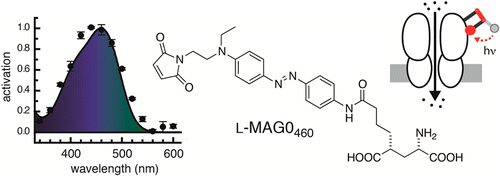
A red-shifted, fast-relaxing azobenzene photoswitch for visible light control of an ionotropic glutamate receptor
Abstract
The use of azobenzene photoswitches has become a dependable method for rapid and exact modulation of biological processes and material science systems. The requirement of ultraviolet light for azobenzene isomerization is not ideal for biological systems due to poor tissue penetration and potentially damaging effects. While modified azobenzene cores with a red-shifted cis-to-trans isomerization have been previously described, they have not yet been incorporated into a powerful method to control protein function: the photoswitchable tethered ligand (PTL) approach. We report the synthesis and characterization of a red-shifted PTL, L-MAG0460, for the light-gated ionotropic glutamate receptor LiGluR. In cultured mammalian cells, the LiGluR+L-MAG0460 system is activated rapidly by illumination with 400–520 nm light to generate a large ionic current. The current rapidly turns off in the dark as the PTL relaxes thermally back to the trans configuration. The visible light excitation and single-wavelength behavior considerably simplify use and should improve utilization in tissue.